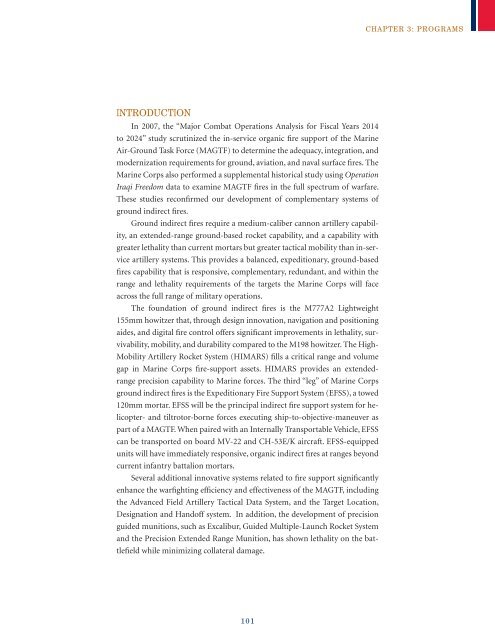USMC Concepts & Programs 2013 - Defense Innovation Marketplace
USMC Concepts & Programs 2013 - Defense Innovation Marketplace
USMC Concepts & Programs 2013 - Defense Innovation Marketplace
Create successful ePaper yourself
Turn your PDF publications into a flip-book with our unique Google optimized e-Paper software.
chapter 3: programs<br />
Introduction<br />
In 2007, the “Major Combat Operations Analysis for Fiscal Years 2014<br />
to 2024” study scrutinized the in-service organic fire support of the Marine<br />
Air-Ground Task Force (MAGTF) to determine the adequacy, integration, and<br />
modernization requirements for ground, aviation, and naval surface fires. The<br />
Marine Corps also performed a supplemental historical study using Operation<br />
Iraqi Freedom data to examine MAGTF fires in the full spectrum of warfare.<br />
These studies reconfirmed our development of complementary systems of<br />
ground indirect fires.<br />
Ground indirect fires require a medium-caliber cannon artillery capability,<br />
an extended-range ground-based rocket capability, and a capability with<br />
greater lethality than current mortars but greater tactical mobility than in-service<br />
artillery systems. This provides a balanced, expeditionary, ground-based<br />
fires capability that is responsive, complementary, redundant, and within the<br />
range and lethality requirements of the targets the Marine Corps will face<br />
across the full range of military operations.<br />
The foundation of ground indirect fires is the M777A2 Lightweight<br />
155mm howitzer that, through design innovation, navigation and positioning<br />
aides, and digital fire control offers significant improvements in lethality, survivability,<br />
mobility, and durability compared to the M198 howitzer. The High-<br />
Mobility Artillery Rocket System (HIMARS) fills a critical range and volume<br />
gap in Marine Corps fire-support assets. HIMARS provides an extendedrange<br />
precision capability to Marine forces. The third “leg” of Marine Corps<br />
ground indirect fires is the Expeditionary Fire Support System (EFSS), a towed<br />
120mm mortar. EFSS will be the principal indirect fire support system for helicopter-<br />
and tiltrotor-borne forces executing ship-to-objective-maneuver as<br />
part of a MAGTF. When paired with an Internally Transportable Vehicle, EFSS<br />
can be transported on board MV-22 and CH-53E/K aircraft. EFSS-equipped<br />
units will have immediately responsive, organic indirect fires at ranges beyond<br />
current infantry battalion mortars.<br />
Several additional innovative systems related to fire support significantly<br />
enhance the warfighting efficiency and effectiveness of the MAGTF, including<br />
the Advanced Field Artillery Tactical Data System, and the Target Location,<br />
Designation and Handoff system. In addition, the development of precision<br />
guided munitions, such as Excalibur, Guided Multiple-Launch Rocket System<br />
and the Precision Extended Range Munition, has shown lethality on the battlefield<br />
while minimizing collateral damage.<br />
101

















